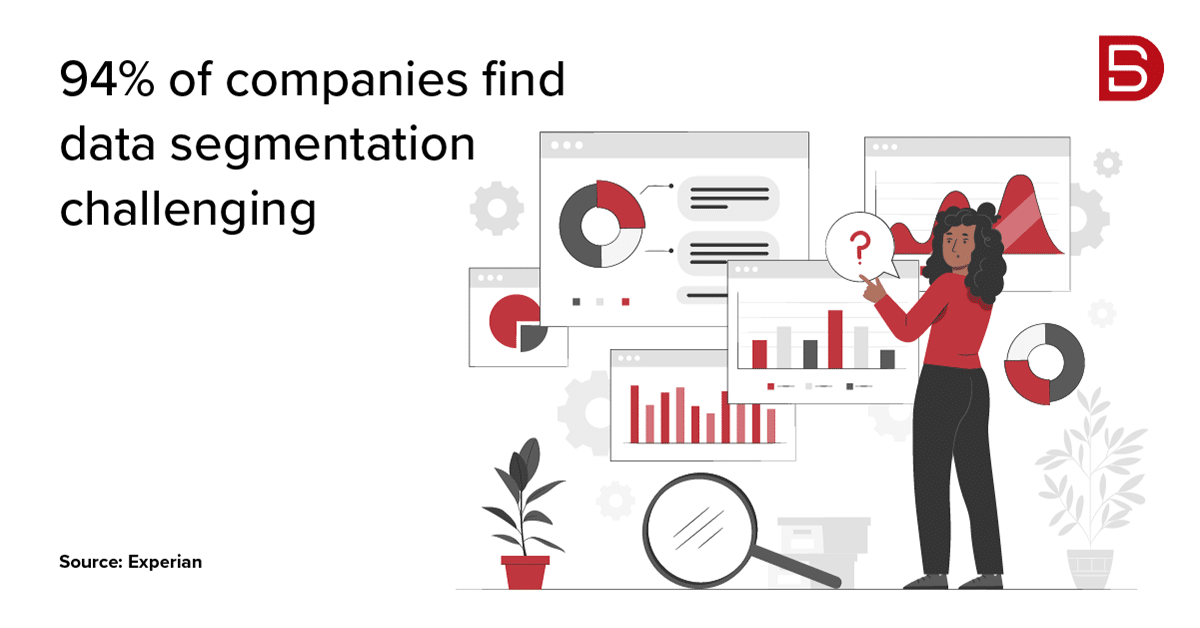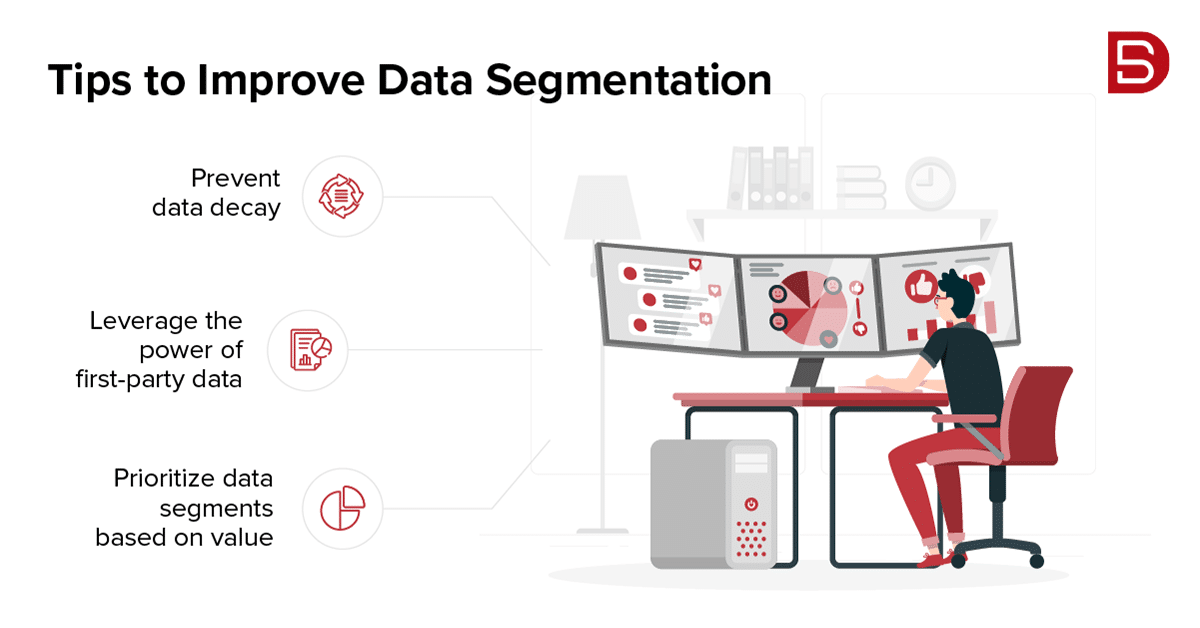Data-driven strategies have become indispensable for B2B businesses. It’s evident that nowadays customers increasingly prefer personalized experiences over cookie-cutter sales tactics. And who wouldn’t?
By using some straightforward data-driven marketing tricks, businesses can zero in on their most promising prospects, and this often leads to a much higher chance of success. According to HubSpot, marketers who meticulously segment customer data for their campaigns have witnessed revenue increases of a staggering 760%.
Further, Mailchimp’s recent reports state that segmented email campaigns have shown a fantastic 23% increase in open rates and an impressive 49% jump in click-through rates compared to campaigns that aren’t segmented. But the advantages of data segmentation stretch far beyond email marketing, impacting various facets of your business strategy. Let’s explore how you can harness the power of data segmentation for your B2B success.
What is Data Segmentation?
Data segmentation involves breaking down account-related data into specific categories using various criteria. This process enhances the data’s usability for marketing and sales efforts.
When data remains unsegmented, it can pose significant challenges for new business development teams. B2B companies need to exercise caution with the overwhelming influx of raw information, often referred to as “data exhaust.” This influx can potentially lead marketing and sales teams to make ill-informed decisions, resulting in wasted resources, time, and money.
However, data segmentation simplifies the process of gathering, evaluating, and integrating customer data. This data is invaluable for creating precise Ideal Customer Profiles (ICPs), which serve as the driving force behind B2B account-based marketing strategies.
Segmentation Vs. Targeting
It’s important to understand the difference between segmentation and targeting since they’re closely related yet carry different meanings.
As we discussed earlier, segmentation is the process of organizing data to make it more useful. For example, when running a cold email campaign, you can categorize your list based on criteria like job titles, company size, technographics, or other identifiers.
This approach ensures that you can effectively and precisely target everyone on your list. Segmenting your data significantly enhances the precision and efficiency of your targeting efforts. Now, let’s delve into the role that targeting plays in all of this.
Targeting is the practice that guides your sales and marketing teams in choosing the most effective strategies to reach your specific audience. This might involve deciding which channels are best for connecting with your ideal clients, such as choosing between advertising on Twitter or LinkedIn.
It’s crucial to emphasize that segmentation lays the foundation for effective targeting. Without a well-defined segmentation strategy, your targeting efforts won’t achieve the level of precision required. This lack of precision could pose challenges for your sales team when sending cold emails, making it difficult to attain success and close deals because they might be reaching the wrong audience.
Key Benefits of Data Segmentation
Creating well-defined data segments has benefits across the entire business. Let’s consider why your company should pay close attention to your data segmentation practices.
• Lead Generation
Every day, your sales and marketing folks rely on B2B data to make informed decisions regarding their outreach strategies. It’s crucial for your team to have a deep understanding of your top clients, their specific interests, and the most effective communication methods.
Data segmentation significantly enhances your team’s efficiency by enabling them to tailor their interactions and messages to resonate with these high-value clients. Additionally, these insights can be leveraged for lead scoring, allowing your team to prioritize and focus their efforts on the most promising accounts in your sales pipeline.
• Boost Success Rate in Cold Outreach
Utilizing data segmentation can be a game-changer for improving your team’s cold outreach success rate. By leveraging segmentation, your team can pinpoint accounts that align with your SQL criteria before initiating contact.
Equipping your sales team with valuable insights into a company’s firmographic and technographic details, along with knowledge about key decision-makers, results in significant time savings. With the advantage of precise targeting and tailored messages based on this acquired knowledge, your cold email success rate is bound to see a notable increase.
• Create Personalized Messages
Data segmentation plays a pivotal role in personalization, by enabling you to know your users on a deeper level. It helps you sort your audience into specific groups based on their common characteristics, be it their age, browsing habits, or preferences.
This approach isn’t just about making your users feel special – it’s about delivering content, recommendations, and marketing messages that truly resonate with each group. This, in turn, leads to increased relevance and engagement, making users more likely to take action, whether it’s making a purchase or staying loyal to your brand.
• Optimize Resource Allocation
Data segmentation helps in identifying high-value customer segments and tailoring your marketing strategies and resource allocation to prioritize these segments. By customizing your efforts and budget to meet the specific needs and preferences of these segments, you can increase ROI and reduce resource waste. This approach allows for more efficient use of your resources, better performance monitoring, and improved scalability as your business grows.
Challenges to Effective Data Segmentation
Although segmenting your data is an important process, many firms find it difficult to execute well. Let’s look at some typical problems that businesses encounter and how to solve them.
1. Gaining Prompt Insights
Segmenting data can be time-consuming, leading to frustration within the organization and delaying the benefits. And let’s face it, if it drags on for too long, patience wears thin across the board, and those advantages we’re all looking for seem like a distant dream.
To streamline the process, begin by asking a fundamental question: “What’s the purpose of data segmentation?” Once you have a clear goal in mind, you can organize and utilize the data promptly. This empowers your sales team with precise, segmented prospect lists, ensuring they connect with the right people at the right time. With actionable insights, your marketing team can then create new initiatives and refine their targeting strategies effectively.
2. Sufficient Data Availability
You might be wondering if you have enough data for effective database segmentation. Well, in most cases, the answer is likely “yes,” especially if you have paying clients in your customer base.
Here’s a practical approach: start by diving into your existing customer data, where valuable insights often hide. Begin by identifying your top-tier clients, usually those with the highest Customer Lifetime Value (CLTV), as we mentioned earlier. This exercise can reveal noteworthy patterns. Imagine this scenario: your premium clients frequently engage with a specific feature more than your other customers.
This observation might suggest that these clients share common challenges or needs. With this knowledge, your sales team can strategically address these prevalent pain points in their cold emails or calls, increasing the likelihood of closing more business.
Furthermore, you can tap into data from sources like Google Analytics, derived from your website, or utilize audience engagement data from Facebook Ads. These datasets serve as valuable resources for refining your targeting and data segmentation processes.
3. Inaccurate Data
It’s worth noting that your contact database may contain inaccuracies, as indicated by the 28% bounce rate of B2B sales emails. As you’re aware, the effectiveness of your sales team is closely tied to the quality of your data. The ability to identify and connect with high-quality leads hinges on data accuracy.
The good news is that you can take proactive steps to alleviate the time-consuming challenges posed by data inaccuracies. To begin, consider implementing data quality measures for validation.
For instance, before launching a cold email campaign targeting prospects, consider employing email validation tools to thoroughly verify contact information. This ensures that your outreach efforts are built on a solid foundation of accurate and up-to-date data.
Should these challenges seem daunting or infeasible to tackle on your own, remember that you can always explore the option of partnering with a trusted B2B data solutions provider. They specialize in navigating the intricacies of data segmentation, allowing you to focus on what you do best – growing your business.
Data Segmentation Methods for B2B Companies
Selecting the right criteria to categorize a large pool of data based on shared characteristics is pivotal for the success of customer data segmentation in B2B companies.
While there are more detailed segmentation methods that dive even deeper into understanding the unique characteristics linking each contact within a specific group, the most common and practical ways to segment customer data include:
• Lead Attribution
This process hones in on critical lead characteristics that are invaluable for creating comprehensive client profiles. These characteristics encompass elements like location, age, gender, company size, educational background, and personal interests.
The initial filter serves as a valuable tool for your team, enabling them to pinpoint the specific traits of a client or prospect that hold the utmost significance in your lead generation process. This could encompass factors such as decision-making authority, industry expertise, and availability.
Even though it might seem like Marketing 101, paying attention to a company’s firmographic, geographic, and demographic data segments can be instrumental in crafting client profiles with exceptional conversion potential within a market that your team has identified as lucrative.
• Behavioral Attribution
Behavioral analytics can dig into why prospects make certain choices, but the real power of this approach lies in spotting patterns, habits, and how receptive they are to your segmentation efforts. To put it simply, the aim here is to help you connect the dots between your leads and the digital channels you use to engage with them. Every online action a user takes leaves behind valuable data, showing you when, where, and how your contacts engage with your digital initiatives.
The more high-quality B2B data your company can gather, analyze, and use, the better equipped you’ll be to create personalized outreach campaigns that boost conversion rates and keep your customers happy.
• Buyer Persona Attribution
Buyer persona categorization proves immensely valuable for organizing your audience data based on the traits of your most profitable contacts. To establish a robust buyer persona, you’ve likely already conducted some level of customer data segmentation, pinpointing the criteria to consider.
A buyer persona essentially paints a picture of your ideal client. It enables you to grasp their needs, create a tailored communication strategy, and formulate both inbound and outbound approaches that foster meaningful interactions with your business.
It’s important not to confuse this with an ideal consumer profile, which offers a comprehensive description of a business most likely to become your client. This includes details like decision-makers’ names, recommended follow-up strategies, their positions within the target account list, and more.
The distinction between the two lies in the fact that the Ideal Customer Profile (ICP) defines which businesses and titles to target, while the buyer persona guides you on how to effectively target them. By incorporating the various customer data segmentation categories discussed earlier, your marketing and sales teams will have a clear roadmap for executing their engagement strategies.
Tips to Elevate B2B Data Segmentation
By incorporating the following data-driven segmentation tips into your marketing and sales funnels, you can ensure that your lead generation campaigns are targeting the right prospects through the right channels:
1. Prevent Data Decay
Data decay is the term used to describe the inevitable process of data deterioration over time. If your sales and marketing teams aren’t attentive enough to maintain your CRM up to date, inaccurate, incomplete, and outdated information could snowball out of hand. The most crucial aspects of data quality that you must monitor are:
- Accuracy: How accurate is your information?
- Completeness: How extensive is the data contained in your pipelines?
- Consistency: How precise are the sources of your data?
- Timeliness: Are you up to date with your information?
- Validity: Does your information actually contribute to what you are measuring?
- Uniqueness: How unique is the information you use?
The efficiency of data-based campaigns can be compromised by computer glitches, human error, or a failure to keep up with the influx of new information.
To maintain a healthy database, establish data quality standards, gather all of your data in one location, and foster a corporate culture that places a high value on data.
2. Leverage The Power Of First-Party Data
First-party data comprises information voluntarily provided by prospects through actions like filling out application forms, sending direct messages, or subscribing to a blog. This data suggests that when handled correctly, these contacts have a higher potential to become customers and are genuinely interested in your product or services.
You can obtain second-party data from a trusted business partner. These datasets typically maintain a high level of accuracy because they were collected with the permission of clients. On the flip side, third-party data is acquired from data aggregators and often comes with challenges in verifying its source, leading to debates about its reliability and compliance with privacy regulations.
Even though third and second-party data sources may seem reliable, nothing beats working with firsthand information. While it may require more time and effort to manage, prioritizing first-party data in your data segmentation strategies is a worthwhile investment.
3. Prioritize Your Data Segments Based On Value
The aim of data segmentation in marketing is to understand your customers better by dividing them into different categories based on their characteristics. This helps you create detailed profiles for each group, which, in turn, allows you to personalize your marketing efforts.
When you have a list of customers, some may be frequent buyers, some are new prospects, and others may have shown a lot of interest in your products. By prioritizing these groups based on their importance, you can create tailored marketing strategies for each. For example, you might send special offers to frequent buyers and informative content to prospects.
In simple terms, data segmentation helps you treat your customers like individuals, addressing their specific needs and preferences, which increases the chances of making sales and building customer loyalty.
Wrapping Up
Over time, data not only gets vast and more complex, but it also demands smarter methods to extract its full value. This means that B2B data-driven companies need to group similar clients into more specialized categories.
The good news is that in the future, technology will likely provide organizations with nearly perfect buyer personas. This shared understanding of how products match customer demand will make it easier for sales teams to connect with potential clients. For marketers and sales folks, it’s crucial to grasp the importance of organizing, analyzing, and maintaining their current data. The knowledge they gather today will be the foundation for successful customer engagement strategies in the future.
If you wish to drive your B2B marketing campaigns with precision, write to us at marketing@datamaticsbpm.com. Our comprehensive B2B custom data solutions can provide you with precise technographic, demographic and firmographic data to accelerate your campaign outcomes with accurate and customized database services.
 Select an element to maximize. Press ESC to cancel.
Select an element to maximize. Press ESC to cancel.
Henry Romano




